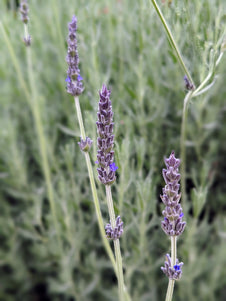





Lavender - Allardii Lavender
Lavender - Allardii Lavender

- Low stock - 8 items left
- Inventory on the way

Usually available: All year
Life cycle: Perennial
Height: 1.3m
Position: Full sun
Soil preference: Well drained
This is how we pack and send your Herb Plants to all states except TAS & WA
You will receive
- 1 Allardii Lavender Herb Plant in a 50 X 75mm tube - General growing instructions
All of our Herb Plants are grown organically with certified organic potting mixes and fertilizers
Botanical Name: Lavandula 'Allardii'
Lavender ‘Allardi’ is an evergreen plant growing to 1.3 H and 1.0 W, although it has been reported to grow higher. The plant structure is quite dense and mound shaped, with the flower spikes adding height. The flower spikes, or wands, are among the tallest of all lavenders at 30 to 40 cm. The purple flowers have small bracts separating each one. They are fragrant and are also considered to be the largest among the lavenders. The blooming period of this lavender is not as long as others, extending from late spring to early summer. The foliage is soft with gently toothed leaves and green –grey colouring that is highly ornamental. The lavender aroma is strong and camphor like.
Lavender is a much loved garden plant with a long history and many modern cultivars. The Lavandula genus belongs to the Laminaceae family, which is also known as the mint family. It has over 3500 species, from more than 180 genera, distributed across the globe. Most of this family of plants come from the Mediterranean and regions with similar climates. They are well suited to growing in the wide range of Australian conditions.
Lavandula X allardii is a hybrid of French Lavender, L. dentata and L. latifolia, an English Lavender, also known as ‘spike lavender’. The parent Spike Lavender has provided the camphor-like scent and the long slender wands that hold the purple blooms. French Lavender L. dentata, has contributed the small bracts and slightly serrated leaves to this hybrid. Due to its size, this lavender may be known as Giant Lavender in some regions. The botanical species name ‘allardii’ is often adjusted to ‘Allardi’ and used as the common name.
Each variety is distinctive and may have different properties including those specific to medicinal or culinary uses. Lavandula X allardii is very useful for hedging, due to its height and less prolific flowering period. For further information, please check our other lavender plant listings including French Lavender.
Growing Conditions
L. allardii is best grown in full sun to part shade and in well drained, average but fertile soil types. It will not do well in clay soils, so containers or raised garden beds may be helpful. Like many lavender species, it is considered tolerant of dry conditions once established. Lavender ‘Allardi’ is one of the best lavenders for warm and humid areas like the sub-tropics. If humidity is a concern make sure that there is plenty of space around each plant to allow for air circulation. Make sure the soil has good drainage and avoid over watering to prevent damp and fungal problems.
Given its suitability for warm regions, it is no surprise that this lavender does not suit areas subject to frost. It may grow well in containers if required or if shelter from winter frosts is needed. Regular pruning is needed after flowering to ensure the plant does not look scrappy. The blooming period is short compared to other lavender varieties. This helps particularly when using L. allardii as a hedge, since there are not many droopy or dried flowers, while other blooms are still fresh. When planting several plants leave plenty of space because the flower spikes are very long adding width to the plant if they extend at an angle.
Medicinal Uses
There are many lavender varieties that have been used for medicinal purposes and that have developed strong folklore in their natural, or wild, habitat. Generally lavender is used for treating exhaustion, nervousness, tension, headaches, insomnia, colic, and promoting relaxation. Each variety may have slightly different active constituents, present in different proportions, so each may have been used for different purposes.
Culinary Uses
Some lavender varieties are more useful than others for culinary purposes. An interesting suggestion is to add some sprigs to roast chicken dishes, instead of rosemary sprigs. Flowers may be added sparingly to salads for colour and taste, or add the buds to scones or honey. Crystallised flowers are suitable for decorating deserts. Use ‘Allardi’ Lavender sparingly in cooking because of its camphor undertones.
Other Uses
Lavender ‘Allardi’ may be used to discourage flies by rubbing it on the kitchen counter or anywhere else that might be suitable. It is also useful for oils, soaps, candles, pot pourri, dried flower crafts and similar activities. Sachets or pillows of dried lavender may be used to place in cupboards or drawers to repel moths. Lavender stalks may be burned to deodorize or cleanse rooms and impart a nice relaxing scent.
All information provided on this website is for informational purposes only. Please seek professional advice before commencing any treatment.





